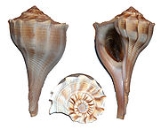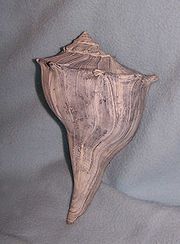
Lightning whelk
Encyclopedia
The lightning whelk, scientific name Busycon contrarium, is an edible species
of very large predatory sea snail
or whelk
, a marine
gastropod mollusk in the family
Buccinidae
, the busycon whelks. This species has a left-handed or sinistral shell. It eats mostly bivalves, sucking their mass up with its proboscis
.
 This species is native to southeastern North America
This species is native to southeastern North America
,south to Florida
and the Gulf
states.

s used these animals as food, and used their shells for tools, ornaments, containers and shell gorget
s. They may have believed the sinistral nature of the lightning whelk shell made it a sacred object.
The lightning whelk is the State Shell of Texas.
, a gigantic lightning whelk is the first boss the player encounters. It is depicted as a large snail that absorbs thunder energy into its shell and releases it as an electrical attack.
Species
In biology, a species is one of the basic units of biological classification and a taxonomic rank. A species is often defined as a group of organisms capable of interbreeding and producing fertile offspring. While in many cases this definition is adequate, more precise or differing measures are...
of very large predatory sea snail
Snail
Snail is a common name applied to most of the members of the molluscan class Gastropoda that have coiled shells in the adult stage. When the word is used in its most general sense, it includes sea snails, land snails and freshwater snails. The word snail without any qualifier is however more often...
or whelk
Whelk
Whelk, also spelled welk or even "wilks", is a common name used to mean one or more kinds of sea snail. The species, genera and families referred to using this common name vary a great deal from one geographic area to another...
, a marine
Marine (ocean)
Marine is an umbrella term. As an adjective it is usually applicable to things relating to the sea or ocean, such as marine biology, marine ecology and marine geology...
gastropod mollusk in the family
Family (biology)
In biological classification, family is* a taxonomic rank. Other well-known ranks are life, domain, kingdom, phylum, class, order, genus, and species, with family fitting between order and genus. As for the other well-known ranks, there is the option of an immediately lower rank, indicated by the...
Buccinidae
Buccinidae
Buccinidae is a very large and diverse taxonomic family of large sea snails, often known as whelks or true whelks.True whelks are mostly marine gastropod mollusks in the clade Neogastropoda...
, the busycon whelks. This species has a left-handed or sinistral shell. It eats mostly bivalves, sucking their mass up with its proboscis
Proboscis
A proboscis is an elongated appendage from the head of an animal, either a vertebrate or an invertebrate. In simpler terms, a proboscis is the straw-like mouth found in several varieties of species.-Etymology:...
.
Distribution

North America
North America is a continent wholly within the Northern Hemisphere and almost wholly within the Western Hemisphere. It is also considered a northern subcontinent of the Americas...
,south to Florida
Florida
Florida is a state in the southeastern United States, located on the nation's Atlantic and Gulf coasts. It is bordered to the west by the Gulf of Mexico, to the north by Alabama and Georgia and to the east by the Atlantic Ocean. With a population of 18,801,310 as measured by the 2010 census, it...
and the Gulf
Gulf of Mexico
The Gulf of Mexico is a partially landlocked ocean basin largely surrounded by the North American continent and the island of Cuba. It is bounded on the northeast, north and northwest by the Gulf Coast of the United States, on the southwest and south by Mexico, and on the southeast by Cuba. In...
states.
Busycon contrarium and B. carica
This species shares many characteristics with its sister species, the knobbed whelk Busycon carica, but there are some important differences:- Lightning whelks are sinistral in coiling while knobbed whelks are dextral
- Lightning whelks have a lower spireSpire (mollusc)A spire is a descriptive term for part of the coiled shell of mollusks. The word is a convenient aid in describing shells, but it does not refer to a very precise part of shell anatomy: the spire consists of all of the whorls except for the body whorl...
than the knobbed whelk - The knobs of the lightning whelk are usually less well-developed than those of the knobbed whelk
- Lightning whelks are diurnal while knobbed whelks are active both day and night
- Lightning whelks prefer to stay in deeper waters than the knobbed whelks when feeding on mud flats

Human use
For thousands of years Native AmericanIndigenous peoples of the Americas
The indigenous peoples of the Americas are the pre-Columbian inhabitants of North and South America, their descendants and other ethnic groups who are identified with those peoples. Indigenous peoples are known in Canada as Aboriginal peoples, and in the United States as Native Americans...
s used these animals as food, and used their shells for tools, ornaments, containers and shell gorget
Shell gorget
A shell gorget is a Native American art form of polished, carved shell pendants worn around the neck. The gorgets are frequently engraved, and are sometimes highlighted with pigments, or fenestrated ....
s. They may have believed the sinistral nature of the lightning whelk shell made it a sacred object.
The lightning whelk is the State Shell of Texas.
In popular culture
In the 1994 video game Final Fantasy VIFinal Fantasy VI
is a role-playing video game developed and published by Square , released in 1994 for the Super Nintendo Entertainment System as a part of the Final Fantasy series. Set in a fantasy world with a technology level equivalent to that of the Second Industrial Revolution, the game's story focuses on a...
, a gigantic lightning whelk is the first boss the player encounters. It is depicted as a large snail that absorbs thunder energy into its shell and releases it as an electrical attack.

